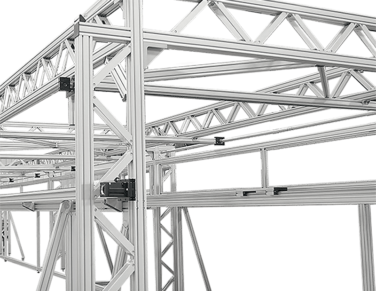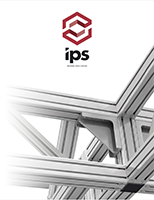T Slot Aluminum Framing – The Basics of Building Structures
 Whether you’re building a machine structure, a material handling system, a test bench or other work equipment, t slot aluminum framing makes it easy. The 6105 T5 aluminum material sold by IPS is extruded to tight tolerances and is both strong and stiff. What’s more, corrosion-resistance means there’s no need to consider painting or coating, unless for the sake of appearance.
Whether you’re building a machine structure, a material handling system, a test bench or other work equipment, t slot aluminum framing makes it easy. The 6105 T5 aluminum material sold by IPS is extruded to tight tolerances and is both strong and stiff. What’s more, corrosion-resistance means there’s no need to consider painting or coating, unless for the sake of appearance.
Designing and building with t slot aluminum framing is little different to fabricating metal structures. Start by considering function and loads, and then sketch out structures to suit. However, the wide range of available extruded profiles and accessories means there are a few points to consider. Here’s a look at the basics of building structures with this material.
Consider Function and Loads
Many aluminum t slot structures will never see heavy loads. Workbenches, tables, test stands, storage equipment and machine guarding are just some examples. Others however may experience both static and dynamic forces.
Machine structures can be subject to high loads. These might be clamping forces or the weight of a workpiece or tooling. Packaging equipment could carry heavy reels of material and filling or dispensing machinery might be loaded up with drums of adhesive or other liquid.
Dynamic loads occur where there’s motion. This is often found in material handling systems. Part feeders, loaders and gantry systems often have linear motion which can momentarily impose high loads on the supporting structure. T slot aluminum framing can still be used in these applications, but it’s important to select the right type.
Minimize Unsupported Lengths
Extruded aluminum performs like an I-beam in the way it resists bending. However, to maximize strength and rigidity in your structure, minimize distances between supports and avoid cantilevers where the extrusion is only supported at one end.
Choose Your Profile
Two aspects of aluminum framing to consider are the cross-section and weight of the extrusion. Cross-sections are specified in either inch or metric, with the latter having a larger range of sizes to choose from. A larger section corresponds to higher strength, and rectangular section framing provides higher bending resistance over the longer dimension.
Weight refers to the thickness of aluminum in the profile. Heavy-duty applications, which includes those with dynamic loads, should use L8 profile which is the heaviest per linear foot. Applications with no or minimal loads – frames for display boards and signs are an example – can use light-duty L5 weight, while for most uses mid-range L6 profile will suffice.
Design Joints With Care
Making a 90° joint with t slot aluminum framing involves butting the end of one length of extrusion against the side of another. In this kind of joint consider the direction the primary load acts, (usually vertically downwards under the influence of gravity.)
In a weak joint, one length is only held in place by friction: no matter how much torque is applied to the fastener, with enough load the length will move. This is avoided by arranging the pieces so the load is transferred down directly through the upright extrusion. Add supplemental gusset pieces to increase joint stiffness.
Work With Product Specialists
If you’re able to come up with a concept for what you need, but are unsure of which profile to use or how it should go together, IPS can help. We offer a no-cost engineering service where we determine the exact sizes and lengths of framing, plus all the accessories needed. We’ll give you this in the form of a parts list and then when you’re ready we’ll produce a kit that’s ready for assembly. It really couldn’t be any easier.

